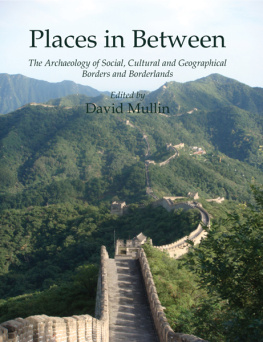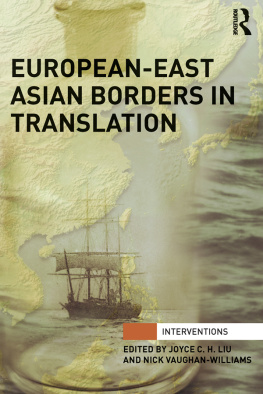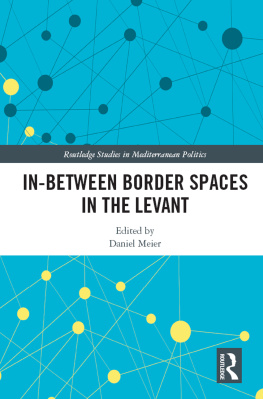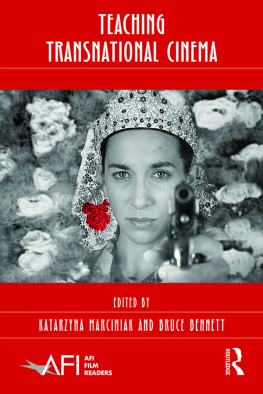Border Visions
Identity and Diaspora in Film
Edited by Jakub Kazecki, Karen A. Ritzenhoff, and Cynthia J. Miller
THE SCARECROW PRESS, INC.
Lanham Toronto Plymouth, UK
2013
Published by Scarecrow Press, Inc.
A wholly owned subsidiary of The Rowman & Littlefield Publishing Group, Inc.
4501 Forbes Boulevard, Suite 200, Lanham, Maryland 20706
www.rowman.com
10 Thornbury Road, Plymouth PL6 7PP, United Kingdom
Copyright 2013 by Scarecrow Press, Inc.
All rights reserved . No part of this book may be reproduced in any form or by any electronic or mechanical means, including information storage and retrieval systems, without written permission from the publisher, except by a reviewer who may quote passages in a review.
British Library Cataloguing in Publication Information Available
Library of Congress Cataloging-in-Publication Data
Border visions : identity and diaspora in film / edited by Jakub Kazecki, Karen A. Ritzenhoff, Cynthia J. Miller.
pages cm
Includes bibliographical references and index.
ISBN 978-0-8108-9050-3 (cloth : alk. paper) ISBN 978-0-8108-9051-0 (ebook) 1. Boundaries in motion pictures. 2. Identity (Psychology) in motion pictures. I. Kazecki, Jakub. II. Ritzenhoff, Karen A. III. Miller, Cynthia J., 1958
PN1995.9.B67B67 2013
791.43dc23 2013007500
 The paper used in this publication meets the minimum requirements of American National Standard for Information SciencesPermanence of Paper for Printed Library Materials, ANSI/NISO Z39.48-1992. Printed in the United States of America.
The paper used in this publication meets the minimum requirements of American National Standard for Information SciencesPermanence of Paper for Printed Library Materials, ANSI/NISO Z39.48-1992. Printed in the United States of America.
The editors would like to dedicate this book to all border crossers searching for a way to share their experience with us.
To my wife, Raluca, my best travel companionand to my daughter, Iana, who just joined us on our journey.
Jakub Kazecki
To my mother, Birgit Franz, who taught me the joy of languages and travel.
Karen A. Ritzenhoff
To my aunt Helen, whose journeys across the worlds borders inspired me as a child, and whose sense of adventure, at ninety-eight, inspires me still.
Cynthia J. Miller
Foreword
On LoveOn Borders
Laila Pakalnia Translated by Maruta Z. Vitols
I belong to those directors who, when asked, What is your new film about? reply, About love. This is because, when Im making a film, Im more interested in the question How? and not About what? Of course, I usually dont even really know what to say, but to respond About love seems the most appropriate, since all of my work is always somehow, to some degree, about love.
Yet, now, after becoming acquainted with the contents of the anthology Border Visions: Identity and Diaspora in Film , I have gained a new, more appropriate and deeper answer to the question, What is your new film about? About borders, of course. And I like this answer much better, because it encompasses both subject and form. Film, as a work of art, comes into existence destroying or overcoming the border between subject and form.
Furthermore, specifically, film always is entirely born from and experienced as the border between darkness and light. One needs both darkness and light to capture and develop cinematic images. Without this recognition of the border between light and darkness, the digital process isnt possible, eitherthe point of cinema is to create the frame precisely from these borders. From an even more sacred perspective: how does the spectator experience film? In a dark room with a lit screen. From a more personal point of view: what do filmmakers call the magic hour, the most precious and beautiful time of the day to film? The border between night and day, and day and night. The time when the sun is close to or just below the horizon. Because of this, the light isnt direct, flat, or sharp like it is midday. Instead, it is soft, filtering its beams from the sky. Moreover, the farther away you are from the equator, the longer you can enjoy this magic. Im luckyI live and work in Latvia. And it is far enough away from the equator to permit me to utilize this border time between day and night (light and dark).
In addition, I live in a land not only where it is possible to film during the magic hours, but also where one experiences all four seasons; that is, enough seasons to pick which one I like the best. Therefore, whenever the production schedule allows, I prefer to film when the seasons are changing, on those borders. For example, I like the time of the year when the leaves on trees are just forming buds, or when they no longer are on the branches. It is then that the tree trunks add a graphic quality to the landscape and become powerful elements of the frames composition.
Furthermore, without denying that all of my films are about these kinds of borders, I must admit that I have repeatedly been preoccupied with concrete, physical borders as the settings for my films and with how these tangible boundaries create conflicts that serve as subjects for my works. And who knows? Perhaps it is exactly this unconscious obsession with borders that led me to become a film director (or, at least, the kind of director that I am todayI make both nonfiction and fiction films). One of my first documentary films (which would later bring me to the Cannes Film Festival), The Ferry ( Prmis , 1994), is filmed on the border between Latvia and Belarus. This is where the Daugava River serves as the boundary. We filmed for one year (from summer to summer), showing how the ferry transported people, horses, and cars from one side of the river to the other. In doing so, we actually filmed Latvias regaining of independence in its everyday, social expression. While Latvia and Belarus are part of the Soviet Union, there really is no border between these two republicsthe river is just a river, and people cross it from one shore to the other. They call on relatives, go to the store, visit cemeteries, and so on. It all is so simple and banal, just as how the fly buzzes, how the cow moos, and how the children laugh. And then, suddenlythe river is a border, the ferry no longer runs its course. A border guard sits at the side of the river. Latvia has become an independent state. But, the fly continues to buzz.
Next, when I was working on my first fiction film (as a person who was convinced she would never make fiction films), I was drawn to a particular topic because I suddenly remembered my mothers story about an occurrence during the Soviet era in her (and my) home town of Liepja. During the Soviet period, this seaside town was an imperial border city, because, on the other side of the Baltic Sea, lived capitaliststhe Swedes. This border between socialism and capitalism was very carefully guardedthe inhabitants of the town were allowed to go to the beach only during the day, since the authorities plowed and patrolled the strip to ensure that no enemy of the Soviet Union could secretly creep into the country. However, my mother told me that, during her youth in the 1950s, some girl had fooled the border patrol. During the night, she walked backward across the plowed beach into the water and then stepped in her own footprints to get away. The next morning, an alarm was sounded in the townthe border guards were searching for a spy who had emerged from the sea and had infiltrated Soviet territory. I suddenly remembered this story and understoodthis is a movie. I only added a shoe (which, unlike Cinderellas footwear, was very big) that the girl loses on the border, and I called the film The Shoe ( Kurpe , 1998).
And then, of course, there is The Bus ( Autobuss , 2004). Before Latvia became a member of the European Union, the Estonian cameraman Arko Okk and I understood that we had to film the bus route between Tallinn and Kaliningrad, since, during the span of one night, it crosses three borders. This meant that the passengers experienced six real border crossings (and, for example, they required four different currencies in order to use the local rest stops). During the production of this film, I was forced to consider the boundaries of the viewers patience. One of the scenes that I absolutely had to include in the film was five minutes long, which, perhaps, still isnt so terrible. However, during this scene, nothing happenspeople stand in line and dont move. This is the passport control at Russias Kaliningrad border, where all of the bus passengers have to disembark from the vehicle. They stand in line and wait in absolute silence until the Russian border guard decides to stamp one passport. After five minutes of doing nothing, the guard stamps the passport, and the line moves forward by one person. I had to preserve this humiliation of the passengers in my film, because, without the need for any words, it displayed how the military official enjoyed his power (and, therefore, revealed his small-mindedness). Of course, I couldnt afford to include a five-minute-long scene in the film, not only because the spectators probably wouldnt be able to stand it, but also because this kind of scene would destroy the films rhythm. Moreover, I still needed space in that work for many other scenes.










 The paper used in this publication meets the minimum requirements of American National Standard for Information SciencesPermanence of Paper for Printed Library Materials, ANSI/NISO Z39.48-1992. Printed in the United States of America.
The paper used in this publication meets the minimum requirements of American National Standard for Information SciencesPermanence of Paper for Printed Library Materials, ANSI/NISO Z39.48-1992. Printed in the United States of America.